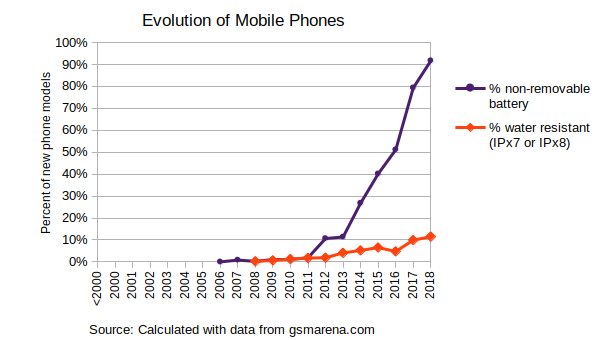@bluez, My experience has been the exact opposite. Every laptop that I have ever owned (mostly Thinkpads in the last 15 years) have had significant battery degradation after 2 years of usage. By the third year, the battery was only good for about 30 minutes of use.
For phones, the degradation hasn’t been nearly as bad, but I rarely use my phone more than 20 minutes per day. Some people use their phones 6 hours per day and have to recharge their phones every night, so they probably do have the same degradation as I see on my laptops. My girlfriend had to throw away her last phone (Huawei) because the battery got so bad that she could only turn it on if it was plugged into the charger.
I cannot believe that there is no market demand for phones with replaceable batteries. When the entire mobile phone industry decided to get rid of replaceable batteries in 2016-7, I saw comment after comment in the reviews for phones from people saying that they wouldn’t buy such-and-such phone if it didn’t have a replaceable battery.
At this point, everyone has accepted that there is no alternative, because the mobile phone industry refuses to make decent phones with replaceable batteries. If you want a phone with a replaceable battery, you either have to buy a used phone from 2016 or get a really low-end phone. Most people don’t want a used phone from 2016 and they don’t want a crappy bottom-of-barrel phone, so they have no choice but buy phones with non-replaceable batteries.
Only 6.2% (26 out of 418) of the smartphone models introduced in 2019 had a replaceable battery according to the gsmarena database, and only one of those 26 models have a Snapdragon processor (the Moto E6 with a Snapdragon 435). Considering that the world makes 1.8 billion cellular phones per year, I can’t believe that there isn’t enough demand for at least ONE mid-range or high-range smartphone with a replaceable battery.

The only way that I can explain what happened is that the entire mobile phone industry decided to stop producing high-end mobile phone with replaceable batteries in 2016, because it realized that mobile phone sales were going to start dropping and planned obsolescence was the best way to force consumers to keep buying new phones.
Yes, some consumers value water resistance more than a replaceable battery or a slim case more than a replaceable battery, but I can’t believe that 100% of buyers of mid-range and upper-range phones decided between 2016 and 2017 that they no longer wanted replaceable batteries. This looks too much like a concerted and planned effort by the industry to get rid of replaceable batteries in order to stimulate sales, because consumers were starting to keep their existing phones for longer.
Average number of months before users upgrade their smartphone
| Region |
2013 |
2014 |
2015 |
2016 |
2017 |
2018 |
| United States |
20.5 |
20.9 |
21.6 |
22.7 |
23.6 |
24.7 |
| Urban China |
18.6 |
21.8 |
19.5 |
20.2 |
21.0 |
21.0 |
| Western Europe* |
18.3 |
19.5 |
20.4 |
21.6 / 23.4 |
24.9 |
26.2 |
- Western Europe includes UK, France, Germany, Italy, Spain
- Kantar appears to have recalculated the European average in 2016, since it was 21.6 months in the report at Business Insider (2017-03-02), but later reported as 23.4 months by CNBC (2019-05-16).
- Source: Kantar Worldpanel
I wouldn’t get so mad about this if it didn’t have severe environmental consequences, but all this needless fabrication of electronics is depleting the world’s reserves of vital metals that have a limited supply and it is generating greenhouse gases, since 80% of total emissions for smartphones occur during the production phase.
There is only one solution that I can foresee. We need governments to tell the mobile phone industry that that governmental agencies will only buy models that have replaceable batteries, and that will force the industry to start making models with replaceable batteries again.
